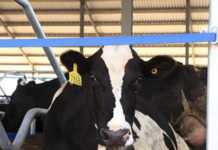Since cattle were first domesticated in about 5000BC in a place called Katal in present day Turkey, stock farmers have come a long way in breeding diverse types of cattle from a single ancestral species.Evidence shows that modern breeds were mostly selected on a phenotypic (visual appearance) basis. Before Gregor Mendel started his work on inheritance factors in the 1860s nobody knew anything about the genetic basis of phenotypes.
Beef producers in modern times have the relatively easy task of selecting on the correlation between conformation and beef production. Beef production has many other factors on which animals are selected, bred and multiplied. These include hardiness, adaptability, fertility, feed conversion, maternal ability, slaughtering percentage and disease resistance.
The challenge
Dairy farmers have a far more daunting challenge. Many anomalies have to be addressed among the millions of genes within the chromosomes. To illustrate:
- A pure-bred Afrikaner cow on a farm outside Estcourt peaked at 30l/ day during her lactation. This is considered to be phenotypically impossible.
- A big Holstein cow in the Underberg district peaked at 63l/day. She looked like a camel, not like a dairy type cow.
- A high performance cow called Cauliflower was inseminated with semen from the best bull of the 1970s, Exwell Enterprise. At the same time, a cross Jersey/Holstein cow was inseminated with the same semen. Cauliflower’s daughter was useless as a milker whereas the cross-bred’s heifer was above average.
- Lemon Juice, a cow belonging to Viv Turner from Underberg perfectly demonstrated the correlation between phenotype and genetics. She was an exceptional show cow and a high milk producer.
In the light of these few examples among many more anomalies, we must strongly commend the sellers of semen, the production of which is an expensive, long-term process. A general consensus exists throughout the dairy world that the science of genetics is about 20 years ahead of the science of nutrition. My own view is that dairy farming is 12% genetics, 9% feed and 79% management. It is what you do with genetics in terms of management that will determine profitability. This may explain the variation between individual cow performance and the average performance of different herds.
Malcolm Stewart-Burger founded the Society of Master Dairymen and designed the Maxi Milk System. He is currently a part-time consultant to Nutex Feeds and De Heus.













